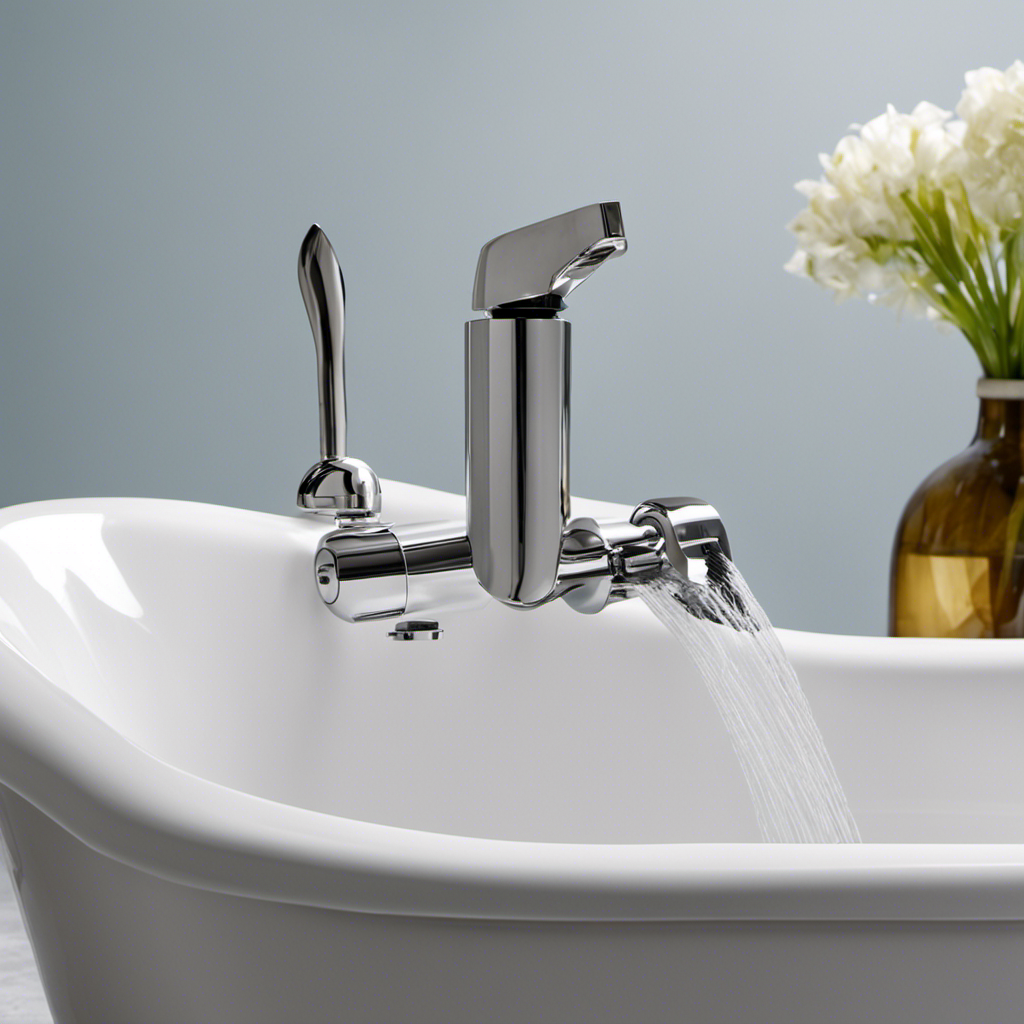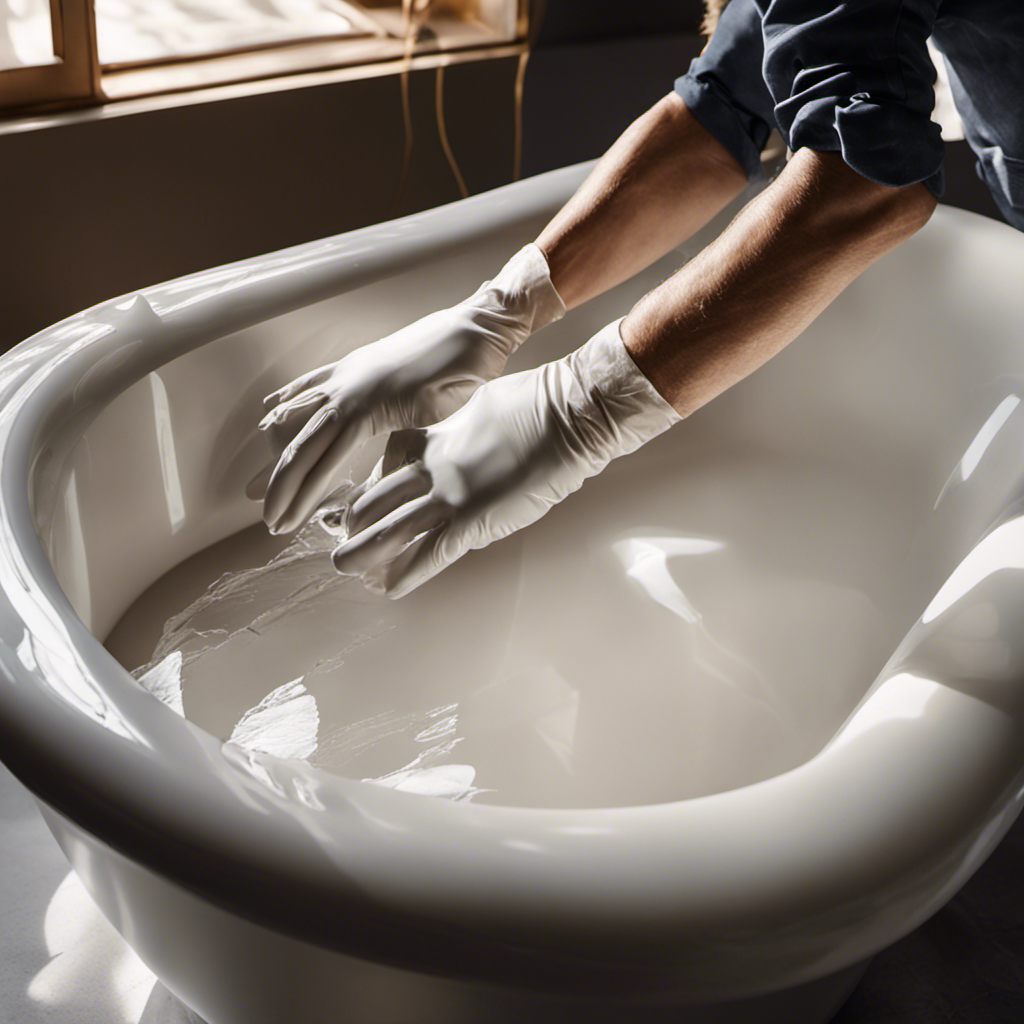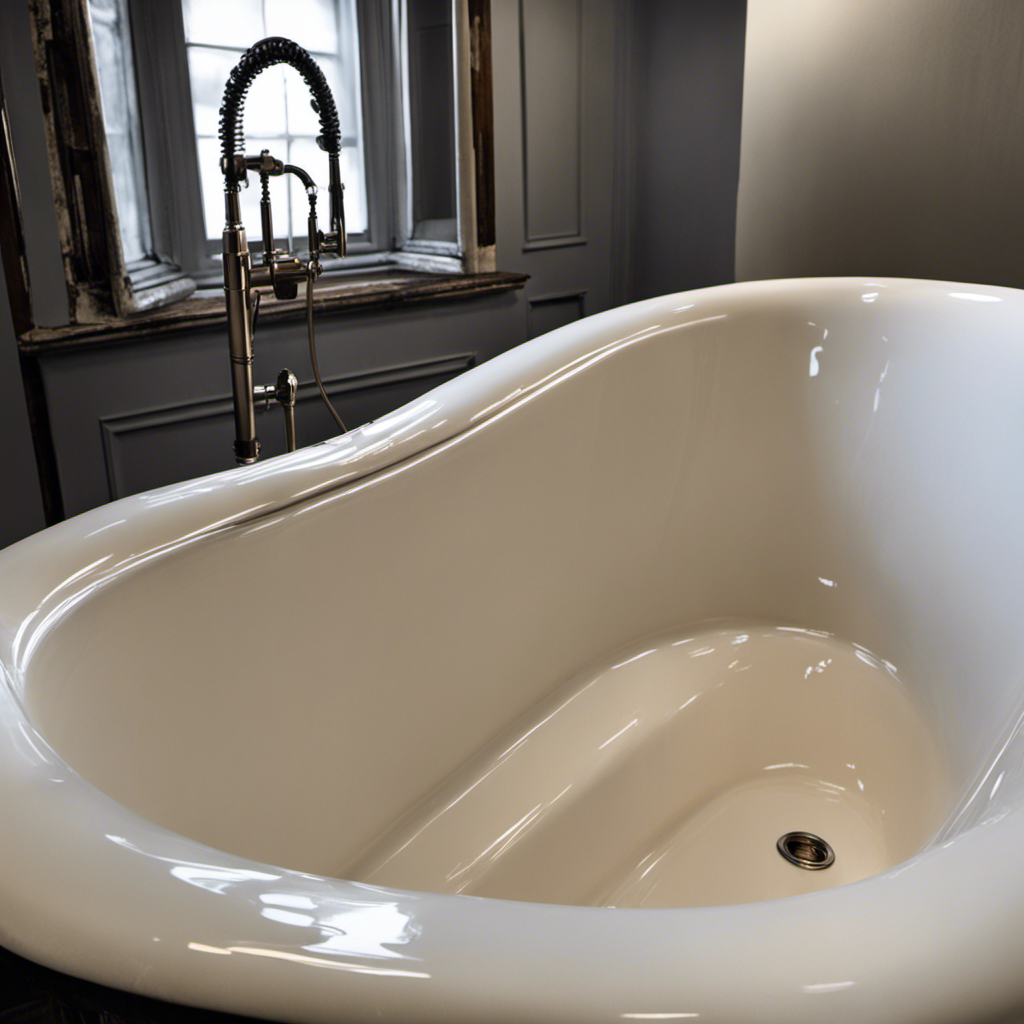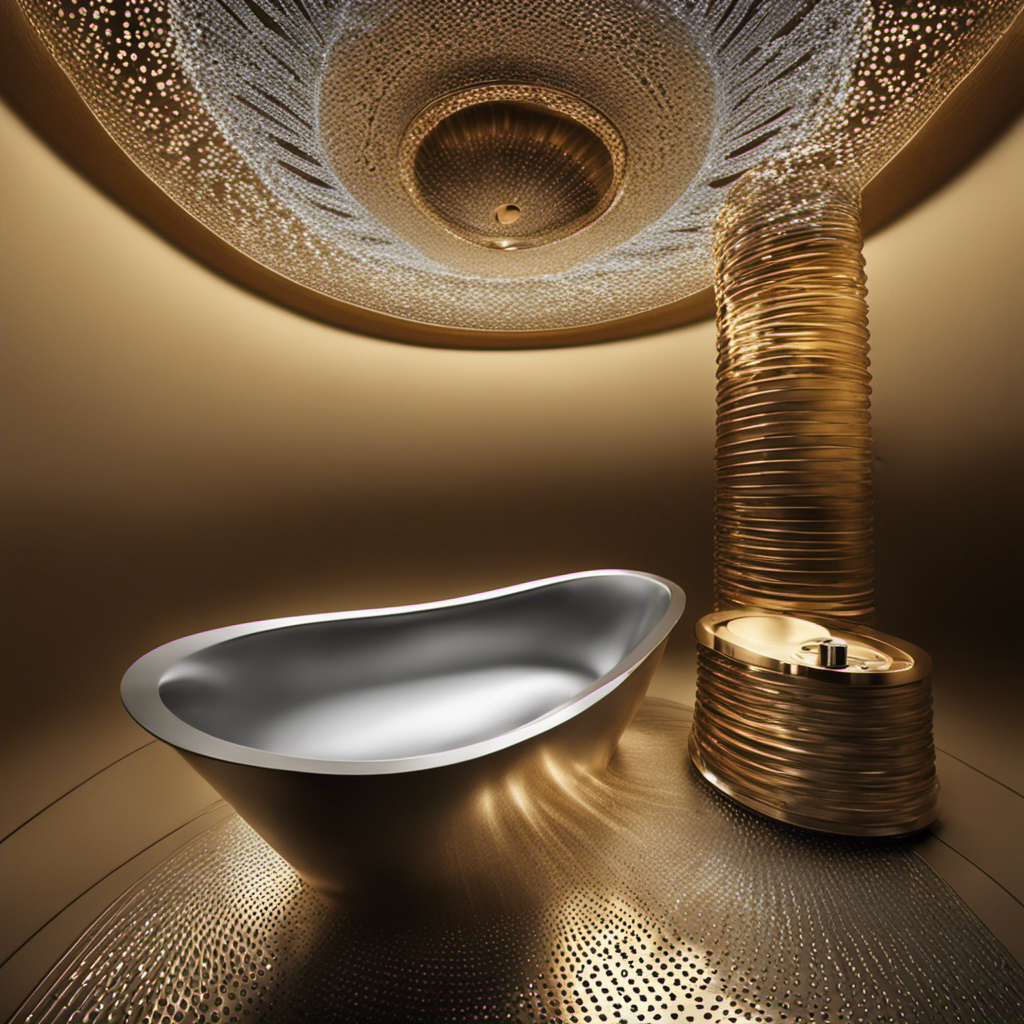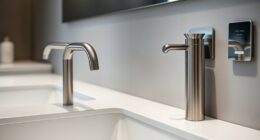Are you tired of dealing with a stubborn bathtub drain stopper that refuses to do its job? Well, fret no more! In this handy guide, we will show you how to fix your bathtub drain stopper using simple yet effective techniques.
From removing and cleaning the stopper to repairing or replacing it, we’ve got you covered. Get ready to reclaim your peaceful bath time and say goodbye to clogged drains.
Let’s dive right in and get your drain stopper functioning flawlessly once again!
Key Takeaways
- There are different types of bathtub drain stoppers to choose from, including rubber, silicone, and metal, each with their own benefits and drawbacks.
- Tools such as pliers, a screwdriver, plumber’s putty or silicone caulk, and a drain key or wrench may be needed to remove and install a new drain stopper.
- Regular cleaning and maintenance of the drain stopper is important to prevent clogs and ensure proper functionality.
- If the drain stopper is not sealing properly, cleaning it thoroughly, repairing or replacing the linkage, lubricating the mechanism, or replacing the stopper altogether may be necessary.
Types of Bathtub Drain Stoppers
Now let’s take a look at the different types of bathtub drain stoppers you can choose from. There are several materials used for bathtub drain stoppers, each with its own pros and cons.
The most common types are rubber, silicone, and metal. Rubber drain stoppers are inexpensive and flexible, but they may not provide a tight seal. Silicone drain stoppers are more durable and offer a better seal, but they can be more expensive. Metal drain stoppers, such as brass or chrome, are sturdy and long-lasting, but they can be prone to corrosion.
When selecting a drain stopper, consider your budget, the level of seal you require, and the desired lifespan of the stopper.
Now, let’s move on to the tools you will need for fixing your bathtub drain stopper.
Tools You Will Need
You’ll need a few tools to get the job done. When it comes to bathtub drain stopper installation and troubleshooting common stopper problems, having the right tools is essential.
First, you’ll need a pair of pliers to remove the old stopper and tighten the new one. A screwdriver will also come in handy for loosening and tightening screws.
To ensure a proper seal, a plumber’s putty or silicone caulk is necessary. Additionally, a drain key or a drain wrench will be needed to remove stubborn drain covers.
Removing the Bathtub Drain Stopper
When it comes to removing a bathtub drain stopper, it’s important to be aware of the different styles that exist.
There are various types of drain stoppers, such as the lift-and-turn, the push-and-pull, and the toe-touch.
Each style requires a different approach for removal, so it’s essential to have the right tools on hand.
Different Drain Stopper Styles
Take a look at the different styles of drain stoppers available for your bathtub.
There are various materials used for drain stoppers, each with their own pros and cons.
First, let’s talk about rubber drain stoppers. These are the most common type and are known for their flexibility and effectiveness in sealing the drain. However, they can deteriorate over time and may need to be replaced more frequently.
Another option is a push-button drain stopper, which is made of metal and offers a more durable solution. It is easy to operate with a simple push, but it may not provide a complete seal.
Lastly, there are flip-top drain stoppers made of plastic. They are convenient to use, but their effectiveness can vary depending on the quality of the mechanism.
Consider these factors when choosing a drain stopper for your bathtub.
Tools Needed for Removal
To remove it, you’ll need a pair of pliers and a screwdriver. These tools are essential for successfully removing the bathtub drain stopper.
Here are three reasons why you should have these tools on hand:
- Pliers provide a firm grip on the stopper, allowing you to easily twist and remove it from the drain.
- A screwdriver is necessary to unscrew any screws or caps that are securing the stopper in place.
- Having both tools ensures that you have the necessary equipment to tackle any type of stopper, whether it’s a push-pull, lift-and-turn, or toe-touch style.
Cleaning the Drain Stopper
Now you can start by cleaning the drain stopper using a mixture of vinegar and baking soda.
Cleaning the drain stopper is an essential step in maintaining the functionality of your bathtub. Over time, the stopper can become clogged with hair, soap scum, and other debris, leading to common problems such as slow drainage or complete blockage.
To clean the stopper, remove it from the drain and rinse it with warm water to remove any loose debris. Then, create a mixture of equal parts vinegar and baking soda and apply it to the stopper. Scrub the stopper gently with a brush to remove any stubborn buildup.
Rinse the stopper thoroughly and reinstall it back into the drain. Regularly cleaning the drain stopper will help prevent future clogs and ensure smooth drainage.
Repairing or Replacing the Drain Stopper
If you’re experiencing issues with your drain, you might want to consider repairing or replacing the stopper. Here are some common problems and solutions to help you decide:
-
Repairing the drain stopper:
-
If the stopper is not sealing properly, try cleaning it thoroughly and removing any debris.
-
If the linkage is broken or disconnected, you can replace it with a new one.
-
If the stopper is stuck in the closed position, lubricate the mechanism with a silicone-based lubricant.
-
Replacing the drain stopper:
-
If the stopper is damaged beyond repair, replacing it might be the best option.
-
If you want to upgrade the stopper to a more efficient or aesthetically pleasing one, replacing is the way to go.
-
If you have tried repairing multiple times without success, replacing the stopper could save you time and effort.
Now that you have considered repairing or replacing the drain stopper, let’s move on to the next step: reinstalling the drain stopper.
Reinstalling the Drain Stopper
To properly reinstall the drain stopper, start by ensuring its proper positioning within the drain hole. Make sure the stopper is aligned and centered before moving on to securing it in place.
Once positioned correctly, secure the stopper by tightening the retaining screw or other fastening mechanism provided, making sure it is snug and secure.
Proper Positioning for Stopper
The stopper should be positioned correctly to ensure proper functioning. Improper positioning can lead to various issues with the bathtub drain stopper. Here are some important points to consider when it comes to bathtub drain stopper positioning:
- Make sure the stopper is aligned properly with the drain hole to create a tight seal.
- Check if the stopper is free from any debris or hair that may hinder its movement.
- Ensure that the stopper is not overly tightened, as this can cause it to get stuck or difficult to operate.
Properly positioning the stopper is crucial in preventing any stopper issues and maintaining the efficiency of your bathtub drain. Once you have positioned the stopper correctly, you can proceed to the next step of securing the stopper in place.
Securing the Stopper
Once you’ve positioned the stopper correctly, you can proceed to secure it in place.
Securing the stopper is an important step in ensuring that it functions properly and prevents any water leakage.
To secure the stopper, locate the screw or lever mechanism underneath the bathtub drain.
Use a screwdriver or your hand to tighten the screw or engage the lever, depending on the type of stopper you have.
Make sure it is snugly fastened to prevent any movement or loosening.
Proper maintenance of the stopper includes regularly checking for any signs of wear or damage, such as cracks or rust.
If you encounter any issues, troubleshooting techniques such as lubricating the mechanism or replacing worn-out parts can help resolve the problem and keep your bathtub drain stopper working efficiently.
Testing the Stopper
Before proceeding further, you should check if the stopper is functioning properly by running water and observing if it effectively blocks the drainage.
To ensure that your bathtub drain stopper is in good working condition, you can employ the following testing methods:
- Fill the bathtub with water and let it drain naturally. Observe if the stopper closes completely and prevents water from escaping.
- Test the stopper by manually lifting and lowering it. It should move smoothly without any resistance.
- Inspect the rubber gasket or seal around the stopper to ensure it is intact and not cracked or damaged.
Troubleshooting Common Issues
First, check if the drain stopper is properly aligned and connected to the lever mechanism. Troubleshooting common issues with your bathtub drain stopper can save you time and money. Here are some common issues you may encounter and their possible solutions:
| Issue | Possible Solution |
|---|---|
| The stopper won’t stay in the closed position | Adjust the linkage rod or replace the stopper |
| The stopper won’t stay in the open position | Clean the stopper or replace it with a new one |
| The stopper is difficult to operate | Lubricate the linkage mechanism or replace the stopper |
If you are looking for alternative stopper options, consider using a push-pull stopper or a lift-and-turn stopper. These options are easy to use and can provide a better seal. Remember, proper maintenance and regular cleaning can help prevent future issues with your bathtub drain stopper.
Maintenance Tips for a Functioning Bathtub Drain Stopper
To ensure your bathtub stopper functions properly, regularly clean and lubricate the linkage mechanism. This is crucial for maintaining the overall functionality of your bathtub drain stopper.
Here are some maintenance tips that will help you keep your stopper in top shape:
- Clean the stopper regularly to remove any hair, soap scum, or debris that may accumulate over time.
- Use a mild detergent or vinegar solution to clean the stopper and prevent clogs.
- Lubricate the linkage mechanism using a silicone-based lubricant to ensure smooth operation and prevent sticking.
Frequently Asked Questions
How Often Should I Clean My Bathtub Drain Stopper?
You should clean your bathtub drain stopper regularly to prevent clogs and maintain proper drainage. Signs of a clogged shower drain include slow draining water and unpleasant odors.
Can I Use Any Type of Drain Stopper for My Bathtub?
You wouldn’t put a square peg in a round hole, would you? The same goes for bathtub drain stoppers. Different types have pros and cons. Follow these tips to choose the right one.
How Do I Know if My Bathtub Drain Stopper Needs Repair or Replacement?
To determine if your bathtub drain stopper needs repair or replacement, look for signs such as water leakage or difficulty in opening/closing. Consider professional help if unsure, but some issues can be fixed with DIY methods.
Can I Fix a Bathtub Drain Stopper Without Any Tools?
Fixing a bathtub drain stopper without tools is like trying to swim without water. While it may seem impossible, there are alternative stoppers available for maintenance. However, proper repairs usually require the use of tools.
What Are Some Common Issues That Can Occur With a Bathtub Drain Stopper and How Can I Fix Them?
There are common issues that can occur with a bathtub drain stopper. You can troubleshoot them and fix them yourself using DIY repair techniques.
Conclusion
In conclusion, fixing a bathtub drain stopper is a relatively simple task that can be done with a few basic tools and some patience. By following the steps outlined in this article, you can easily remove, clean, repair, or replace your drain stopper to ensure proper drainage in your bathtub.
For example, let’s say you have a stubborn hair clog in your drain stopper. By removing and cleaning the stopper, you can effectively remove the clog and prevent future blockages.
Remember, regular maintenance and cleaning are key to keeping your drain stopper functioning properly.
